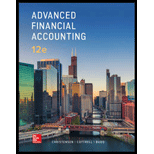
Advanced Financial Accounting
12th Edition
ISBN: 9781259916977
Author: Christensen, Theodore E., COTTRELL, David M., Budd, Cassy
Publisher: Mcgraw-hill Education,
expand_more
expand_more
format_list_bulleted
Question
Chapter 20, Problem 20.5Q
To determine
Introduction: Chapter 11 is a form of bankruptcy proceedings involving reorganization of debtor’s business. Companies usually file Chapter 11 to continue operating and restructure at the same time. It is considered as one of the most expensive restructuring schemes.
To discuss:The account reorganization value in excess of identifiable assets used during chapter 11proceedings.
Expert Solution & Answer
Want to see the full answer?
Check out a sample textbook solution
Students have asked these similar questions
Hi expert please help me
Can you please provide solution this general accounting question?
General Accounting
Chapter 20 Solutions
Advanced Financial Accounting
Ch. 20 - What are the nonjudicial actions available to a...Ch. 20 - What is the difference between a Chapter 7 action...Ch. 20 - Prob. 20.3QCh. 20 - What is usually included in the plan of...Ch. 20 - Prob. 20.5QCh. 20 - Prob. 20.6QCh. 20 - Prob. 20.7QCh. 20 - Prob. 20.8QCh. 20 - How is the statement of affairs used in planning...Ch. 20 - What are the financial reporting responsibilities...
Ch. 20 - Prob. 20.11QCh. 20 - Creditors' Alternatives The creditors of Lost Hope...Ch. 20 - Prob. 20.3CCh. 20 - Prob. 20.1.1ECh. 20 - Prob. 20.1.2ECh. 20 - Prob. 20.1.3ECh. 20 - Prob. 20.1.4ECh. 20 - Prob. 20.1.5ECh. 20 - Prob. 20.2ECh. 20 - Prob. 20.3.1ECh. 20 - Prob. 20.3.2ECh. 20 - Prob. 20.3.3ECh. 20 - Prob. 20.3.4ECh. 20 - Prob. 20.3.5ECh. 20 - Chapter 7 Liquidation Penn Inc.'s assets have the...Ch. 20 - Prob. 20.5ECh. 20 - Chapter 11 Reorganization During the recent...Ch. 20 - Prob. 20.7PCh. 20 - Chapter 7 Liquidation, Statements of Affairs...Ch. 20 - Prob. 20.9P
Knowledge Booster
Learn more about
Need a deep-dive on the concept behind this application? Look no further. Learn more about this topic, accounting and related others by exploring similar questions and additional content below.Similar questions
- Sub. General accountingarrow_forwardSolve this General accounting problemarrow_forwardDuring the month of March, Neji Company used $32,800 of direct materials and incurred $46,100 of direct labor costs. Jacob applied overhead to products in the amount of $21,900. If the cost of goods manufactured was $138,000 and the ending work in process balance was $23,600, the beginning work in process must have been equal to _. Hii tutor give me Answerarrow_forward
- Hello tutor help me with accountingarrow_forwardAxay Corporation had an average days sales outstanding (DSO) period of 22 days in 2022. An analyst predicts that Axay’s DSO will decline in 2023 (due to expected improvements in the company's collections process) to match the industry average of 18 days. Total sales (all on credit) in 2022 were $350 million, and Axay expects total credit sales to increase to $380 million in 2023. To achieve the lower DSO, the change in the average accounts receivable balance from 2022 to 2023 that must occur is closest to: a) -$3.90 million b) -$2.36 million c) $2.85 million d) $3.90 million provide answerarrow_forwardAccounting questionarrow_forward
arrow_back_ios
SEE MORE QUESTIONS
arrow_forward_ios
Recommended textbooks for you
 EBK CONTEMPORARY FINANCIAL MANAGEMENTFinanceISBN:9781337514835Author:MOYERPublisher:CENGAGE LEARNING - CONSIGNMENTPrinciples of Accounting Volume 1AccountingISBN:9781947172685Author:OpenStaxPublisher:OpenStax College
EBK CONTEMPORARY FINANCIAL MANAGEMENTFinanceISBN:9781337514835Author:MOYERPublisher:CENGAGE LEARNING - CONSIGNMENTPrinciples of Accounting Volume 1AccountingISBN:9781947172685Author:OpenStaxPublisher:OpenStax College College Accounting, Chapters 1-27AccountingISBN:9781337794756Author:HEINTZ, James A.Publisher:Cengage Learning,
College Accounting, Chapters 1-27AccountingISBN:9781337794756Author:HEINTZ, James A.Publisher:Cengage Learning,

EBK CONTEMPORARY FINANCIAL MANAGEMENT
Finance
ISBN:9781337514835
Author:MOYER
Publisher:CENGAGE LEARNING - CONSIGNMENT

Principles of Accounting Volume 1
Accounting
ISBN:9781947172685
Author:OpenStax
Publisher:OpenStax College

College Accounting, Chapters 1-27
Accounting
ISBN:9781337794756
Author:HEINTZ, James A.
Publisher:Cengage Learning,
How Bankruptcy Works; Author: Two Cents;https://www.youtube.com/watch?v=tpI0XWjIsqI;License: Standard Youtube License